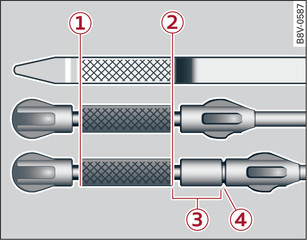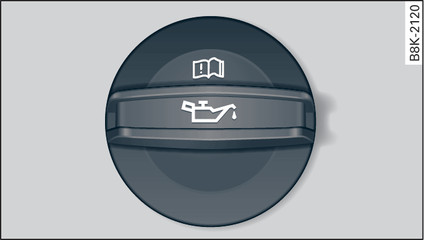|
The oil dipstick differs depending on the type of engine.
Please refer to the safety notes ►.
Checking the engine oil level
- Park the vehicle on a level surface.
- Switch off the warm engine. Wait for a few minutes for the oil to drain back into the sump.
- Open the bonnet link►.
- Pull out the oil dipstick Fig. ►, wipe it with a clean cloth and insert it again, pushing it in as far as it will go.
- Then pull the dipstick out again and check the oil level link►.
- If the oil level is too low, add more engine oil.
Topping up the engine oil
- Unscrew the cap
 Fig. 216► from the oil filler opening Fig. ►.
Fig. 216► from the oil filler opening Fig. ►. - Carefully add 0.5 litres of suitable engine oil link►.
- After two minutes check the oil level once again.
- If the oil level is too low, add a smaller quantity of engine oil. The level must always be below the marking -2- Fig. 215► ►.
- Screw the oil filler cap
 back on and push the dipstick all the way in.
back on and push the dipstick all the way in.
WARNING
- Ensure that no engine oil comes into contact with hot engine components when topping up: this could cause a fire.
- The oil filler cap must be properly closed to prevent oil from squirting onto the hot engine or exhaust system while the engine is running – risk of fire!
- Wash your skin thoroughly if it comes into contact with engine oil.
- The engine oil must never drop below the marking -1- Fig. 215► - risk of engine damage!
- When topping up the engine oil, make sure that the oil level is not above the marking -2- Fig. 215►, as this may result in damage to the catalytic converter or to the engine. Do NOT start the engine. Contact a qualified workshop to extract the engine oil if necessary.
- Applies to vehicles which have an oil dipstick with area -3- Fig. 215►: If you run your vehicle on diesel fuel of poorer quality than EN 590 standard fuel, the fuel can get into the engine oil. In this case, the oil level gradually rises and the quality of the engine oil decreases. Once the oil level has reached the marking -4- or the indicator lamp
 has come on, the engine oil level must not be corrected by extracting the surplus oil - risk of engine damage! The engine oil must be changed link►.
has come on, the engine oil level must not be corrected by extracting the surplus oil - risk of engine damage! The engine oil must be changed link►.
- No additives should be used with engine oil. Any damage caused by the use of such additives would not be covered by the factory warranty.
For the sake of the environment
- Never pour engine oil down drains or into the ground.
- Always observe statutory requirements when disposing of empty oil canisters.
Note
Depending on how you drive and the conditions in which the car is used, oil consumption can be up to 0.5 ltr./1000 km. Oil consumption on RS models can be up to 0.8 ltr./1,000 km. Oil consumption is likely to be higher for the first 5,000 km. For this reason the engine oil level must be checked at regular intervals, preferably when filling the tank and before a journey.


